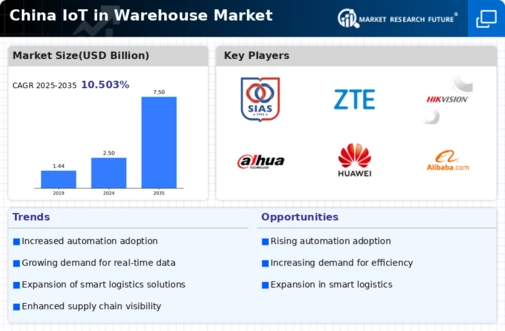Rising Demand for Efficiency
The IoT in-Warehouse Market in China is experiencing a notable surge in demand for operational efficiency. As businesses strive to optimize their supply chains, the integration of IoT technologies is becoming increasingly vital. Companies are leveraging IoT solutions to automate inventory management, reduce human error, and enhance overall productivity. Reports indicate that the adoption of IoT in warehouse operations can lead to efficiency improvements of up to 30%. This drive towards efficiency is not merely a trend but a necessity for companies aiming to remain competitive in a rapidly evolving market. The iot in-warehouse market is thus positioned to grow as organizations seek to implement smart technologies that streamline processes and reduce costs.
Focus on Supply Chain Resilience
In the face of increasing global uncertainties, the focus on supply chain resilience is becoming a critical driver for the IoT in-Warehouse Market in China. Companies are recognizing the importance of building robust supply chains that can withstand disruptions. IoT technologies are being employed to enhance visibility and traceability throughout the supply chain, allowing businesses to respond swiftly to changes in demand or supply. This emphasis on resilience is prompting organizations to invest in IoT solutions that provide real-time insights and predictive analytics. As a result, the iot in-warehouse market is expected to grow as companies prioritize the development of agile and resilient supply chain strategies.
Technological Advancements in IoT
Technological advancements are playing a crucial role in shaping the IoT in-Warehouse Market in China. Innovations in sensor technology, data analytics, and connectivity are enabling warehouses to implement smarter solutions. For instance, the development of low-power wide-area networks (LPWAN) is facilitating better connectivity for IoT devices, allowing for real-time monitoring and control of warehouse operations. These advancements not only improve operational efficiency but also enhance data accuracy and decision-making processes. As technology continues to evolve, the iot in-warehouse market is likely to see increased adoption of cutting-edge solutions that drive productivity and reduce operational costs.
Government Initiatives and Support
The Chinese government is actively promoting the adoption of IoT technologies across various sectors, including the IoT in-Warehouse Market. Initiatives aimed at enhancing technological infrastructure and providing financial incentives for businesses adopting IoT solutions are becoming more prevalent. For instance, the government has allocated substantial funding to support research and development in IoT applications, which is expected to bolster the market significantly. This support not only encourages innovation but also facilitates the integration of advanced technologies in warehouse operations. As a result, the iot in-warehouse market is likely to benefit from favorable policies and increased investment, fostering a conducive environment for growth.
E-commerce Growth and Logistics Needs
The rapid expansion of e-commerce in China is driving the demand for advanced logistics solutions, thereby impacting the IoT in-Warehouse Market. With online retail sales projected to reach over $2 trillion by 2025, the need for efficient warehousing and distribution systems is paramount. IoT technologies are being utilized to enhance inventory tracking, order fulfillment, and real-time data sharing, which are essential for meeting the high expectations of e-commerce consumers. This growth in e-commerce is compelling warehouses to adopt IoT solutions to manage increased volumes and ensure timely deliveries. Consequently, the iot in-warehouse market is poised for significant growth as businesses adapt to the evolving logistics landscape.

















Leave a Comment